送信先をカンマで区切りるだけのようです。
$to = "list1@gmail.com,list2@yahoo.co.jp";
ただ、この仕様だと、一昔前のスパムメールの様に宛先に他の人のアドレスが表示されてしまいます。
これは消したいですね。
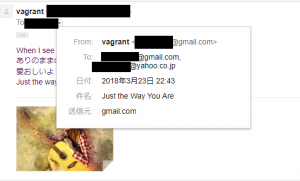
あ、そもそも大量のメール一括送信は mb_send_mail は非推奨のようでした。
ソフトウェアエンジニアの技術ブログ:Software engineer tech blog
随机应变 ABCD: Always Be Coding and … : хороший
送信先をカンマで区切りるだけのようです。
$to = "list1@gmail.com,list2@yahoo.co.jp";
ただ、この仕様だと、一昔前のスパムメールの様に宛先に他の人のアドレスが表示されてしまいます。
これは消したいですね。

あ、そもそも大量のメール一括送信は mb_send_mail は非推奨のようでした。
コードは、画像送信と全く同じ
mb_language("Japanese");
mb_internal_encoding("UTF-8");
$to = "ほげほげ@gmail.com";
$subject = "Just the Way You Are";
$filepath = "test.mp3";
$mime_type = "application/octet-stream";
$boundary = "__BOUNDARY__";
$additional_headers = "Content-Type: multipart/mixed;boundary=\"".$boundary."\"\n";
$message = "--" . $boundary . "\n";
$message .= "Content-Type: text/plain; charset=\"ISO-2022-JP\"\n\n";
$message .= "When I see your face
ありのままの君が
愛おしいよ
Just the way you Are\n";
$message .="--" . $boundary . "\n";
$message .="Content-Type:". $mime_type . "; name=\"" .basename($filepath) . "\"\n";
$message .="Content-Disposition: attachment; filename=\"" .basename($filepath) ."\"\n";
$message .="Content-Transfer-Encoding: base64\n";
$message .= "\n";
$message .= chunk_split(base64_encode(file_get_contents($filepath)))."\n";
$message .="--" . $boundary . "--";
mb_send_mail($to, $subject, $message, $additional_headers);

Gmailだと、そのままブラウザ上で聞けますね。さすが~
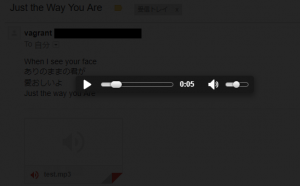
あ、hotmailもいけますね。
※yahooさん(yahoo mail)はダウンロードしないとダメなようですね^^
まず、gif画像を用意

添付ファイルのcontent typeは application/octet-stream で良いようです。
mb_language("Japanese");
mb_internal_encoding("UTF-8");
$to = "hoge@gmail.com";
$subject = "Just the Way You Are";
$filepath = "guitar.gif";
$mime_type = "application/octet-stream";
$boundary = "__BOUNDARY__";
$additional_headers = "Content-Type: multipart/mixed;boundary=\"".$boundary."\"\n";
$message = "--" . $boundary . "\n";
$message .= "Content-Type: text/plain; charset=\"ISO-2022-JP\"\n\n";
$message .= "When I see your face
ありのままの君が
愛おしいよ
Just the way you Are\n";
$message .="--" . $boundary . "\n";
$message .="Content-Type:". $mime_type . "; name=\"" .basename($filepath) . "\"\n";
$message .="Content-Disposition: attachment; filename=\"" .basename($filepath) ."\"\n";
$message .="Content-Transfer-Encoding: base64\n";
$message .= "\n";
$message .= chunk_split(base64_encode(file_get_contents($filepath)))."\n";
$message .="--" . $boundary . "--";
mb_send_mail($to, $subject, $message, $additional_headers);
おおおお!これやべー
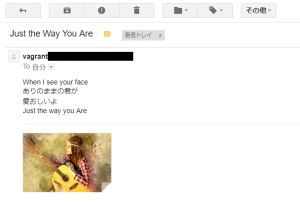
感動した!
Bruno Marsでも送ってみましょう。
headerの箇所はpostfixで設定されているため、削除
$to = "hoge@gmail.com"; $subject = "Just the Way You Are"; $message = "Oh, her eyes, her eyes make the stars look like they're not shinin' Her hair, her hair falls perfectly without her trying She's so beautiful and I tell her everyday"; // $headers = "From: "; mail($to, $subject, $message);
届いています。

いいですね~♪♪♪
では、Atsushiのカバーでいってみましょう。
$subject = "Just the Way You Are"; $message = "When I see your face ありのままの君が 愛おしいよ Just the way you Are"; // $headers = "From: "; mail($to, $subject, $message);
あれ?文字化けせずに届いてますね。ぬぬ。
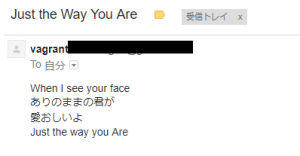
mb_send_mailでも問題なく送信できます。
mb_language("Japanese");
mb_internal_encoding("UTF-8");
$to = "hoge@gmail.com";
$subject = "Just the Way You Are";
$message = "When I see your face
ありのままの君が
愛おしいよ
Just the way you Are";
// $headers = "From: ";
mb_send_mail($to, $subject, $message);
まず完成版から
vagrantのコマンドラインで以下のように打ちます
[vagrant@localhost postfix]$ sendmail myaccount@gmail.com Subject: test test content .
自分のgmailアカウント
vagrantからのメールが届いてますね。

ここまで来るのに5~6時間かかりました。。。
まず、postfixをインストール後、
sudo yum -y install cyrus-sasl-md5 cyrus-sasl-plain
そして、/etc/postfix/main.cfファイルの編集
# 116行目 inet_interfaces = localhostを編集 inet_interfaces = all # 119行目 inet_protocols = allを編集 inet_protocols = ipv4 # 318行目 以下追加 relayhost = [smtp.gmail.com]:587 smtp_use_tls = yes smtp_sasl_auth_enable = yes smtp_sasl_password_maps = hash:/etc/postfix/sasl_passwd smtp_sasl_tls_security_options = noanonymous smtp_sasl_mechanism_filter = plain smtp_sasl_security_options = noanonymous smtp_tls_CApath = /etc/pki/tls/certs/ca-bundle.crt
因みに、main.cfの「318行目」は末尾ではありませんのでご注意を。
続いて、16桁のGmailのアプリパスワードを生成します。
https://secuirty.google.com/settings/security/apppasswords
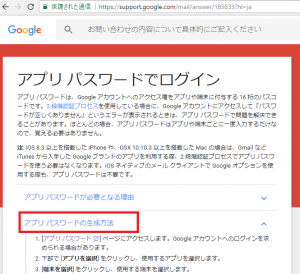
その後、/etc/postfix/に、sasl_passwdファイルをvimで作成します。パスワードはつくったアプリパスワードを入力。
[smtp.gmail.com]:587 example@gmail.com:app_password(16桁)
ここで、passwordにgmailの普通のパスワードを入れると、authentification errorになるのでご注意。
その後、postfixのディレクトリからコマンドラインで
postmap sasl_passwd
として、sasl_passwd.dbを作成します。

そして
sudo service postfix restart
また、gmailの設定で、安全性の低いアプリ(失礼な!)の設定を変更する必要があります。
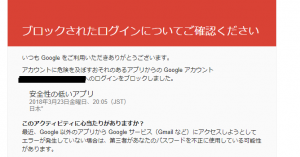
これでsendmailが使えるようになります。あて先は、gmail以外でもOKです。送信元がvagrantになってました。カッコいい!
[vagrant@localhost postfix]$ sendmail myaccount@gmail.com Subject: test test content .
受信されてないようでしたらログを確認。
sudo cat /var/log/maillog
smtp結構複雑ですね。
別のvagrant環境立ち上げて試すなど、迷走しまくってました。。。
postfixを入れます。
更新 : 2:postfix-2.6.6-8.el6.x86_64 1/2 整理中 : 2:postfix-2.6.6-6.el6_7.1.x86_64 2/2 Verifying : 2:postfix-2.6.6-8.el6.x86_64 1/2 Verifying : 2:postfix-2.6.6-6.el6_7.1.x86_64 2/2 更新: postfix.x86_64 2:2.6.6-8.el6 完了しました!
[vagrant@localhost /]$ sudo alternatives --config mta 2 プログラムがあり 'mta' を提供します。 選択 コマンド ----------------------------------------------- 1 /usr/sbin/sendmail.postfix *+ 2 /usr/sbin/sendmail.sendmail Enter を押して現在の選択 [+] を保持するか、選択番号を入力します:1
[vagrant@localhost /]$ sudo chkconfig --add postfix [vagrant@localhost /]$ sudo chkconfig postfix on [vagrant@localhost /]$ chkconfig --list postfix postfix 0:off 1:off 2:on 3:on 4:on 5:on 6:off
SMTPサーバーはメールを相手のメールサーバーまで届けるサーバー
PHPで以下のように書いて
$to = "hoge@gmail.com"; $subject = "TEST MAIL"; $message = "Hello!\r\nThis is TEST MAIL."; $headers = "From: hoge@hoge.com"; mail($to, $subject, $message, $headers); echo "finish!";
以下のようにエラーが出たので
sendmail: fatal: parameter inet_interfaces: no local interface found for ::1
/etc/hostsを修正し
[vagrant@localhost mail]$ vi /etc/hosts 127.0.0.1 localhost localhost.localdomain localhost4 localhost4.localdomain4 #::1 localhost localhost.localdomain localhost6 localhost6.localdomain6
それでも全然finishしないので、SMTPサーバーを調べていたら、
>Postfix 2.10.1 ゲストOS上で稼働するMTA(SMTP)サーバー
>Dovecot 2.2.10 ゲストOS上で稼働するPOP3,IMAPサーバー
なるほど、Postfixをインストールしないといけないのね。
iptables とは、Linux に実装されたパケットフィルタリング型のファイアウォール機能
ファイヤーウォールは本読むと絶対でてきますよね。
さて、iptable
etc/sysconfig/にある
ip6tables-config
iptables-config

機能
1.パケットフィルタリング
送られてきたパケットを検査して設定した条件に該当する場合、設定したアクション(通過、遮断、転送)を実行
2.アドレス変換
送られてきたパケットを検査して設定した条件に該当する場合、パケットの宛先アドレスや送信元アドレスを別のアドレスに書き換え
テーブル
filter パケットのフィルタリングに使用
nat アドレス変換に使用
mangle パケットをNAT以外の目的で置き換えるときに使用
チェイン
INPUT 入力(受信)パケットのチェイン
OUTPUT 出力(送信)パケットのチェイン
FORWARD 転送パケットのチェイン
PREROUTING 受信時に変換するチェイン
POSTROUTING 送信時に変換するチェイン
IPv4とIPv6
IPv6の特徴
-グローバルIPアドレスの数が多い
-セキュリティ機能を標準で装備している
-エンドユーザーの設定が簡単
なるほど、ここまで来たか
以下で可能。
SELECT * FROM tablename WHERE CONCAT(col1,col2) like '%query%';
例:
SELECT * FROM lists WHERE CONCAT(code,name) like ‘%運送%’;
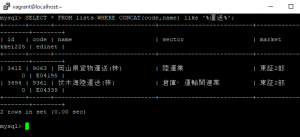
例2:
SELECT * FROM lists WHERE CONCAT(code,name) like ‘%95%’;
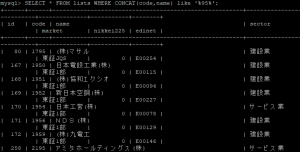
例えば、検索クエリが複数の場合
以下だと、emptyで返ってきます。
SELECT * FROM lists WHERE CONCAT(code,name) like '%三菱 化学%';
ワードを二つに分けて、ANDで繋げます。
SELECT * FROM lists WHERE CONCAT(code,name) like '%三菱%' AND CONCAT(code,name) LIKE '%化学%';
以下のように返ってきます。
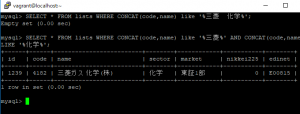
mkdirでフォルダを作成、コマンドラインと同じです。
$dir = "file/test";
if(!file_exists($dir)){
mkdir($dir, 0777);
}
出来てますね。
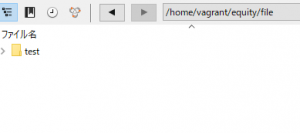
では、約4000個フォルダを作ってみます。
$time_start = microtime(true);
$dsn = "mysql:dbname=equity;host=localhost";
$user = "hoge";
$password = "hogehoge";
try {
$dbh = new PDO($dsn, $user, $password);
} catch (PDOException $e){
print('connection failed:'.$e->getMessage());
}
$sql = "select code from lists";
$stmt = $dbh->query($sql);
while($result = $stmt->fetch(PDO::FETCH_ASSOC)){
$code_list[] = $result["code"];
}
foreach($code_list as $value){
$dir = "file/".$value."";
if(!file_exists($dir)){
mkdir($dir, 0777);
}
}
$time = microtime(true) - $time_start;
echo "{$time}秒";

はや!
